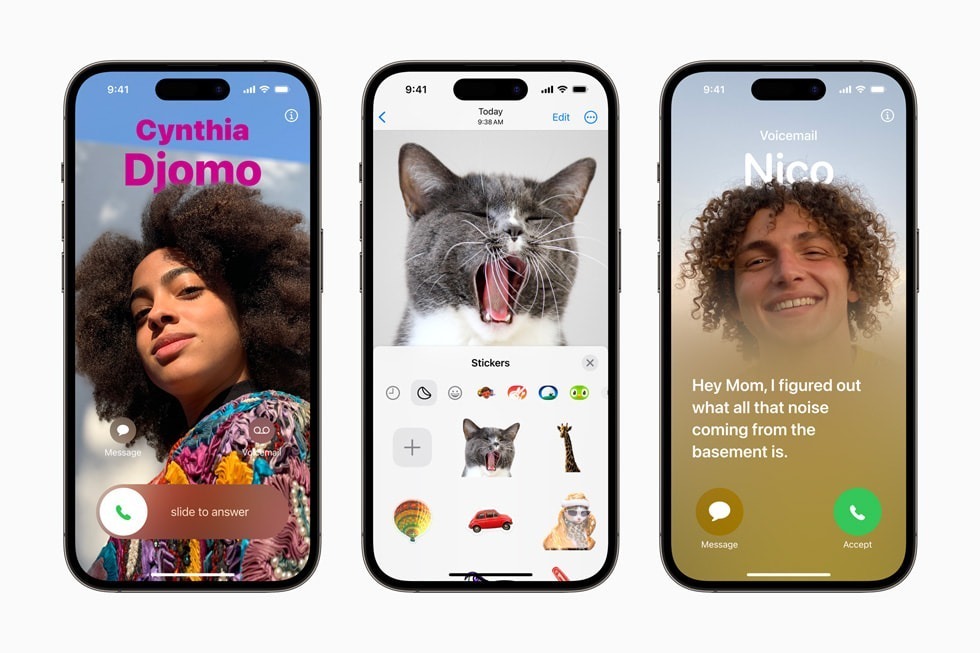Technology
Everything Apple announced at WWDC 2023: Vision Pro headset, iOS 17, the 15-inch MacBook Air and more…
Apple kicked off its 2023 Worldwide Developers Conference keynote Monday. As expected, it announced its new headset, the Vision Pro. The Vision Pro will cost $3,499 when it launches early next year.
Apple announces visionOS software platform for Vision Pro headset
Apple’s Vision Pro headset will run on visionOS a brand-new platform for the Vision Pro headset. It’s a spatial computing platform that developers will be able to build for, much like they would for iOS on iPhone or macOS for Mac.
It will be able to run a multi-app, 3D engine, and Apple said it is the first operating system designed from the ground up for spatial computing.

Apple announces Vision Pro headset for $3,499.
Apple’s headset is finally here, and it’s called Vision Pro. It’ll retail for $3,499, early next year on Apple’s website.
It features exterior cameras, allowing users to interact with digital content in mixed reality. The product will have 2 hours of use on a battery pack that the headset plugs into.
When users don the headset, they arrive at the Home view, a floating set of icons with Apple’s most used apps, including Mail, Music, Messages, and Safari. The system doesn’t need controllers or hardware.
Working with Unity, “hundreds of thousands” of iPad and iPhone apps will run on visionOS at launch. Microsoft’s Office Productivity suite will also work on visionOS.
It’s powered by Apple’s M2 chipset, paired alongside a brand-new chip called R1, designed for “real-time sensor processing.” Those chipsets power Apple’s new operating system, visionOS.
That helps Vision Pro create an “authentic” digital presence for users for video calls, powered by machine learning since the system doesn’t have a camera facing the user.
Using a user’s iris, Optic ID will lock and unlock the Vision Pro.

For vision correction, Apple partnered with Zeiss to build corrective lens add-ons. High-speed IR cameras and LED illuminators track a user’s eyes to free them from “clumsy” controllers, Apple said.
You can control it with hands, eyes, and voice, Tim Cook said. “Relive your most important memories in an entirely new way,” Cook said. The 23-million pixel panel has more pixels than a 4K television per eye, Apple executives said.
Disney CEO Bob Iger also appeared, to tout a partnership between Disney and Apple: enhancing the viewing experience for Disney’s treasure trove of content through Apple’s VR technology.
For example, the demo included a three-dimensional visualization of a basketball court and an immersive National Geographic application that placed the viewer in the ocean.
Disney+ will be available on day one, Iger said.

Apple announces watchOS 10 for Apple Watch with widgets
Apple just announced watchOS 10, the latest software for the Apple Watch.
Here’s what’s new:
- Users can turn the digital crown to reveal widgets, like the weather and calendar.
- Users can long press to add a widget to their smart stack.
- Apple introduced new apps like world clock, which features clocks that have background colors that reflect the time of day.
- When users rotate the digital crown, it shows new, full-screen displays.
- Two new watch faces are available, including a Snoopy and Woodstock watch face and a palate watch face.
- Users can access new active features, like cycling and hiking. Cycling workouts from the watch will show up on paired iPhone devices, and hikers will have access to new topography elevation details.
- Developers will also be able to use new workout APIs, so users can start a workout from apps like Training Peaks, for example.
- In the health app, users will be able to use screening tools and resources to support and evaluate their mental health.
- WatchOS 10 can measure the amount of time users spend in daylight, as well as how close users’ screens are to their eyes. Apple said these new features can help prevent conditions like myopia.
The software will be available to all users next fall.

FaceTime is coming to Apple TV
Apple announced several new tvOS updates on Monday. One highlight: FaceTime is coming to Apple TV. You can use your camera on the iPad or iPhone and view the people you’re talking to on your big screen.
Apple also said you’ll soon be able to find your lost Apple TV remote using FindMy, so long as you have the newer Siri remote.
Apple announces AirPods software updates
Apple announced new audio and home experiences, including new features for its AirPods headphones.
The company introduced adaptive audio, which blends transparency and noise cancellation to match the environment that users are in. It works when listening to music and taking calls.

Apple announces macOS Sonoma for Macs
Apple just announced its latest Mac software. It’s called macOS Sonoma, named for California’s vineyard country. Here’s what’s new:
- New Gaming functionality, taking advantage of Apple’s more powerful graphics processing units and Apple’s Metal 3 framework.
- Expanded video-conferencing functionality through FaceTime. New overlay functions allow customers to appear on-top or alongside their presentations.
- New AR functionality for full-screen reactions that’ll also be available in Zoom, Teams, and WebEx.
- Game Mode will prioritize the game’s utilization of processing power, allowing more consistent framerates.
- Widgets are coming to the macOS on the desktop. They used to live in the Mac’s Notification Center. Like the iPad, they’ll be interactive and developer-enabled.
- Screensavers, like on tvOS, will be coming to macOS.
- Safari is getting some under-the-hood improvements and enhanced Private Browsing functionality.

Apple announces new iPadOS 17 software for iPad
Apple just announced the latest iPadOS 17 software for the iPad.
Here’s a rundown of the new features:
- Multiple timers for iPad, at last. “We truly live in an age of wonders,” Apple executive Craig Federighi said.
- The Health app has been added to the iPad as well.
- Machine-learning tech for PDFs to identify fields even if they’re not built into the PDF.
- Expanded functionality for iPad’s widgets, including enhanced interactivity for third-party developers. Apple showcased functionality for Quizlet.
- New customization options for the iPad lockscreen, similar to how iPhone users can customize their lockscreens. Weather, photo shuffle, and emojis are all part of the offering.
- Live Activity, a la iOS, which creates a widget-like functionality for users to track scores, delivery orders, or other developer-customizable continually updating information.

Apple introduces Standby which lets your iPhone work like a bedside clock
Apple introduced a new experience called Standby, which will show up for users when they place their iPhone on its side using a stand.
The iPhone screen will show the time, and users can pick from a variety of different clocks. Users can also swipe to engage with widgets like weather and home controls. The screen adapts to low light to help users sleep.
Users can also ask Siri to do tasks like play music or set timers, completely hands-free.

Apple announces iOS 17 with a slew of new features
Apple just announced iOS 17, which includes a bunch of changes coming to the iPhone.
Apple is unveiling updates to three apps, Phone, Facetime, and Messages.
- Personalized contact posters, either using photos or Memoji, will allow users to choose their contact card for other users. Live transcription, in real-time, will also be coming for phone voicemails.
- Facetime will finally get a voicemail functionality, allowing users to leave a video message for their friends.
- And messaging will be revamped with more powerful search functionality and a catch-up feature for group chats. You can also see the location of your friends while messaging them.
- New stickers live in a “drawer,” with apparently expanded options including emoji expansion and rotatable optionality.
- Live photos can also be made into an animated sticker.
- A Check-in feature lets you tell a family member or friend when you’re home. Or, if you’re delayed, it’ll tell your friend that, too
- Messaging apps will now have a different layout, expanding to take up the full screen.
- Users can now bump two iPhones or Apple Watches together to share contacts, music, internet, or other shared activities with each other, a feature called “NameDrop.”

Apple unveils new $6,999 Mac Pro with M2 Ultra, replacing Intel chip
Apple just announced a new Mac Pro, its highest-end desktop computer, with the M2 Ultra chip. It’s the last Apple computer to ditch Intel for Apple silicon. It starts at $6,999.
It’ll feature the M2 Ultra’s 24-core CPU, support up to a 76-core GPU, eight Thunderbolt 4 ports, and up to six of Apple’s high-end Pro Display XDR.
Both products can be ordered today for availability next week.
It’s a game-changing move for high-end Apple computers, which historically relied on Intel chipsets until recently.

Apple announces updated Mac Studio with M2 Max or M2 Ultra chips
Apple just announced a series of updates for Mac Studio. It can be configured with either Apple’s M2 Max or M2 Ultra chips.
Apple unveils 15-inch MacBook Air for $1299
Apple just unveiled the 15-inch MacBook Air. It’s 11.5mm thick, just over 3 pounds, and powered by Apple’s own M2 chipset. The video demo showcased a standard headphone jack, two USB-C ports, and Apple’s MagSafe charging dock.
The laptop will ship in four colors, including Midnight and Starlight. The laptop features an 18-hour battery with an 8-core CPU and 10-core GPU
It costs $1,299. The 13-inch version will now cost $1,099. Customers can order it today and it’ll be available next week.



















Recent Comments